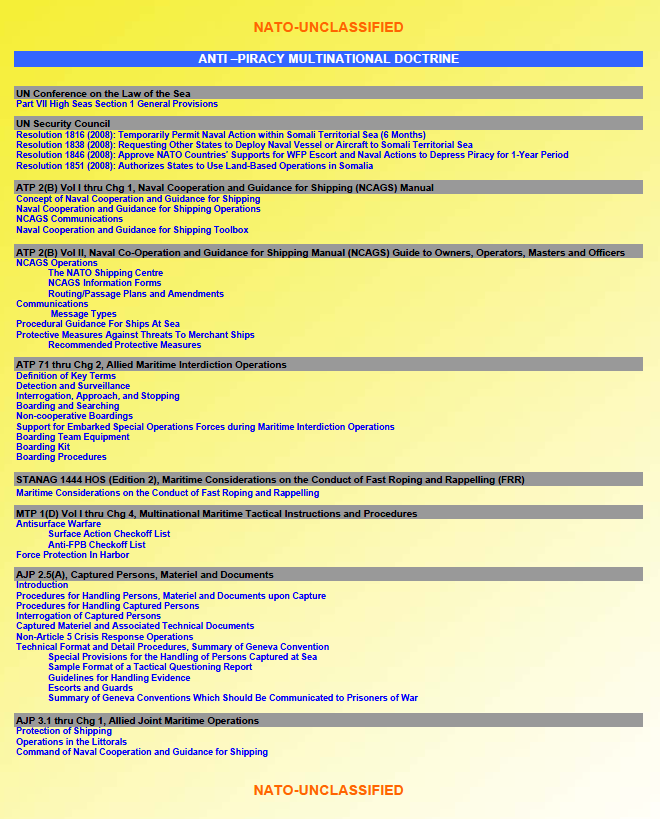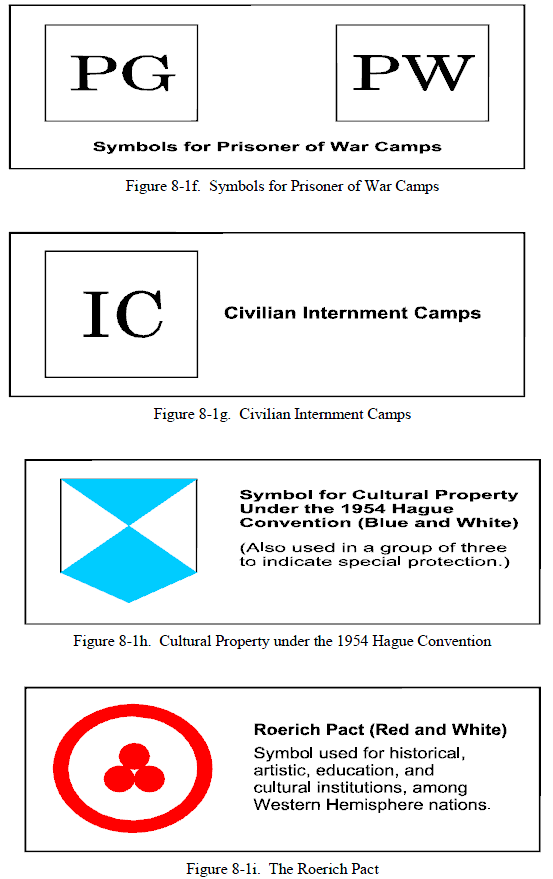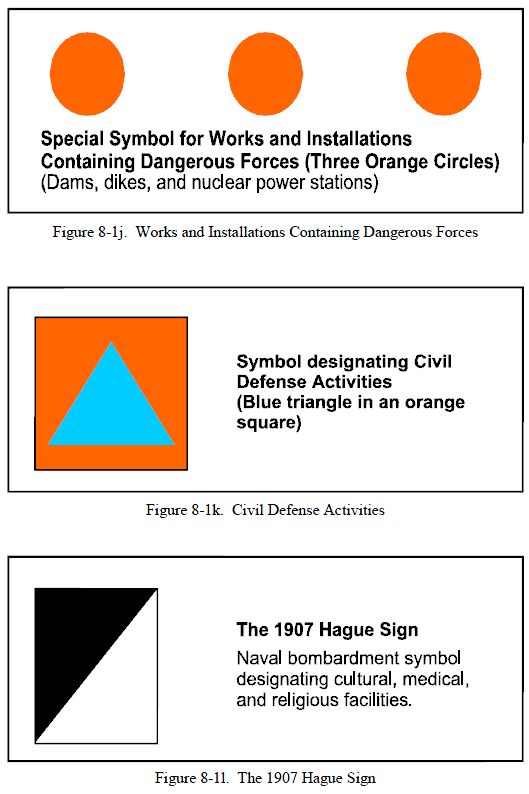 ANTI–PIRACY MULTINATIONAL DOCTRINE
ANTI–PIRACY MULTINATIONAL DOCTRINE
- 813 pages
- NATO Unclassified
- 2008
UN Conference on the Law of the Sea
- Part VII High Seas Section 1 General Provisions
UN Security Council
- Resolution 1816 (2008): Temporarily Permit Naval Action within Somali Territorial Sea (6 Months)
- Resolution 1838 (2008): Requesting Other States to Deploy Naval Vessel or Aircraft to Somali Territorial Sea
- Resolution 1846 (2008): Approve NATO Countries’ Supports for WFP Escort and Naval Actions to Depress Piracy for 1-Year Period
- Resolution 1851 (2008): Authorizes States to Use Land-Based Operations in Somalia
ATP 2(B) Vol I thru Chg 1, Naval Cooperation and Guidance for Shipping (NCAGS) Manual
- Concept of Naval Cooperation and Guidance for Shipping
- Naval Cooperation and Guidance for Shipping Operations
- NCAGS Communications
- Naval Cooperation and Guidance for Shipping Toolbox
ATP 2(B) Vol II, Naval Co-Operation and Guidance for Shipping Manual (NCAGS) Guide to Owners, Operators, Masters and Officers
- NCAGS Operations
- The NATO Shipping Centre
- NCAGS Information Forms
- Routing/Passage Plans and Amendments
- Communications
- Message Types
- Procedural Guidance For Ships At Sea
- Protective Measures Against Threats To Merchant Ships
- Recommended Protective Measures
ATP 71 thru Chg 2, Allied Maritime Interdiction Operations
- Definition of Key Terms
- Detection and Surveillance
- Interrogation, Approach, and Stopping
- Boarding and Searching
- Non-cooperative Boardings
- Support for Embarked Special Operations Forces during Maritime Interdiction Operations
- Boarding Team Equipment
- Boarding Kit
- Boarding Procedures
STANAG 1444 HOS (Edition 2), Maritime Considerations on the Conduct of Fast Roping and Rappelling (FRR)
- Maritime Considerations on the Conduct of Fast Roping and Rappelling
MTP 1(D) Vol I thru Chg 4, Multinational Maritime Tactical Instructions and Procedures
- Antisurface Warfare
- Surface Action Checkoff List
- Anti-FPB Checkoff List
- Force Protection In Harbor
AJP 2.5(A), Captured Persons, Materiel and Documents
- Introduction
- Procedures for Handling Persons, Materiel and Documents upon Capture
- Procedures for Handling Captured Persons
- Interrogation of Captured Persons
- Captured Materiel and Associated Technical Documents
- Non-Article 5 Crisis Response Operations
- Technical Format and Detail Procedures, Summary of Geneva Convention
- Special Provisions for the Handling of Persons Captured at Sea
- Sample Format of a Tactical Questioning Report
- Guidelines for Handling Evidence
- Escorts and Guards
- Summary of Geneva Conventions Which Should Be Communicated to Prisoners of War
AJP 3.1 thru Chg 1, Allied Joint Maritime Operations
- Protection of Shipping
- Operations in the Littorals
- Command of Naval Cooperation and Guidance for Shipping
…
0404 Interrogation Procedures
1. It is imperative that the overall tone of any hailing or interrogation be firm, yet cordial and nonconfrontational. The bridge watch of the suspect vessel may not be proficient in English and may have
to locate someone who is; this person may not necessarily be the master. It is important to ensure the vessel’s master is present during hailing and interrogation, even if the master does not speak English. Due to
accents and colloquialisms, the responses may not be easily understood, with questions having to be repeated more than once. The suspect vessel’s crew should break down the hail into short phrases to assist
in translation or understanding. Request that the vessel spell words, if necessary. A list of ports in the area of operation should be prepared and used as a ready reference. While maintaining a polite attitude, remain alert for any delaying tactics.2. Initial Query. The scripted hailings included in this section should only be used if the MIO commander
does not provide specific scripts.a. A ship or an aircraft may conduct the initial query. The purpose of this query is to obtain the
information about the merchant vessel to determine whether or not a boarding will be required.
Units should make initial contact with the vessel on VHF channel 16, having attracted attention by
night by the use of appropriate coloured light. Interrogation procedures are then conducted on an
assigned VHF working channel. To gain the attention of the vessel, specifically if its name is
unknown, refer to its latitude/longitude position in reference to a known geographic reference
point, course, and speed. In the absence of specific guidance, the following hail is recommended:“Merchant vessel ____________, this is (nation) Navy warship/aircraft. Request
you state your port of origin, your flag, registry, international call sign, your cargo,
your last port of call, next port of call, and final destination, over.”b. If it is determined that a boarding operation will not be necessary based on stated destination, the
following may be used to dispatch the vessel:“Merchant vessel ___________, this is (nation) Navy warship/aircraft. We do not
intend to conduct an inspection. You are instructed to proceed directly to your destination
of _______________. Thank you for your cooperation.”…
0503 Boarding Party Composition
1. The boarding party should be comprised of a minimum of 10 members designated as follows:
a. Boarding Officer. The BO is usually an officer. This member must be mature, in excellent
physical condition, small arms qualified, and have the complete confidence of theCOof the ship.b. Assistant Boarding Officer. The assistant boarding officer (ABO) is usually an officer
who should be in training or qualified as a BO. This member must be in excellent physical
condition, small arms qualified, and have the confidence of the CO of the ship.c. Security Team Leader. The security team leader should be a senior enlisted member of the
boarding ship. This member must be mature, in excellent physical condition, and small arms
qualified.d. Security Team. The security team is a group of five members (usually ratings). They must be
mature, in excellent physical condition, and small arms qualified. Composition of security teams
that are in charge of securing engineering spaces should (when available) include an experienced
engineering officer or rating.e. Search Team. The search team is a group of two of the most experienced and mature men on
the boarding party (senior petty officers preferred). They must be mature, in excellent physical
condition, and small arms qualified. Search team members must be proficient in the use of climbing
equipment in order to conduct container searches.…
MARITIME CONSIDERATIONS ON THE CONDUCT OF FAST ROPING AND RAPPELLING (FRR)
Annex: A. FRR BRIEFING GUIDE FOR AIRCREW/BOARDING PARTY
AIM
1. The aim of this agreement is to specify the detailed requirements for the safe
conduct of maritime cross deck fast roping and rappelling (FRR) utilising national and/or
another nation’s aircraft and personnel.AGREEMENT
2. The participating nations agree to adhere to, as a minimum, the requirements and
procedures specified in this STANAG.GENERAL
3. The requirement exists for NATO nations to be able to conduct combined joint
maritime FRR operations. This may include FRR of a national helicopter and crew
composition to another nation’s deck as well as mixing aircraft and crews from different
nations for a specific operation.4. Before using mixed nation FRR teams for operational missions the formal bi- or
multi-lateral agreement(s) of each participating nation is required. Pre briefing is a
mandatory requirement before conducting cross deck FRR Operations, specifically hand
signals, emergencies and method of descending are to be briefed. An intensive training
phase prior to conducting multinational FRR on an operational level is mandatory. FRR
operations in general should only be undertaken when it is viewed as the most efficient
and practical method of completing a task. The decision to FRR will be decided based on
such constraints as hover height, team member weight, etc.…
Procedures for Handling Captured Persons
0301 General Handling Procedures
1. Standard administrative procedures for the handling of CPERS will be as set out below.
Operational conditions may require deviations from these procedures. Where this is the case, the
principles and procedures will be followed as far as circumstances allow. The provisions of applicable
international law will always be observed.The Detaining Power will at all times be responsible for the care, custody and control of CPERS.
Article 12 of GC3 permits the transfer of POWs from the custody of the Detaining Power to the
custody of another power that has ratified GC3 and has the will and means to uphold the provisions of
the Convention.2. The interrogation of CPERS is set out in Chapter 4 of this publication and should be read in
conjunction with this chapter.3. As soon as possible after capture, individuals are to be provided with tags in accordance with
the procedures outlined in Annex A and collected at a suitable point or area where a GROUPCAPREP
should be compiled (see Annex B).4. Evacuation is to be carried out as soon as the tactical situation permits to one of the following
facilities that should be situated far enough from the combat zone for the CPERS to be out of danger:a. Collecting points.
b. Holding areas.
c. Long-term detention facilities.
d. Medical facilities.
e. Interrogation units (usually collocated with a-c above).
5. Figure 3-1 illustrates the CPERS evacuation chain and lists recommended actions at each stage
in the CPERS handling process.…


